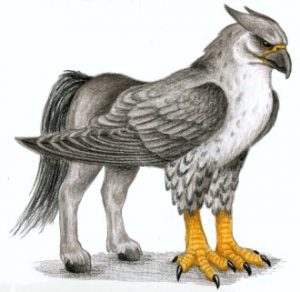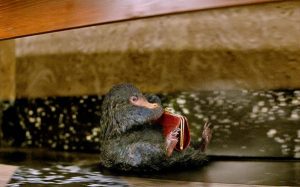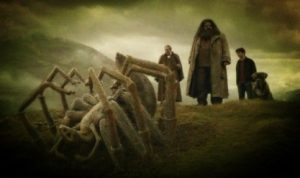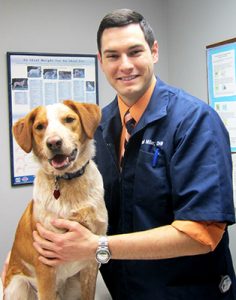
If I had attended Hogwarts, obviously my favorite subject would have been Care of Magical Creatures. Hagrid would have written my recommendation to get into magical veterinary school.
With magic on my mind, I wanted to share lessons that apply to veterinary medicine that I learned from seven of the magical creatures Harry Potter encountered. Even those who aren’t as Potter-crazed as me can still benefit from these tips.
 1. Hippogriffs – Some individuals take extra effort to gain their trust.
1. Hippogriffs – Some individuals take extra effort to gain their trust.
Hippogriffs are half-horse, half-eagle creatures known for attacking when they are insulted. However, if their trust is gained, they will be fiercely loyal and protective. In veterinary medicine, our clients, patients, and co-workers can all be hippogriffs. Some people, and animals, require a gentle approach to win them over. For example, recently I saw a client who was not my biggest fan. Finally, during a stressful appointment, she snapped and let me have it. After allowing her to speak her mind, I calmly explained how I shared her frustration and also shared her desire to figure out how to manage her dog’s condition. By the end of the conversation, she actually apologized for her outburst and told me I had won her over by how I handled the entire situation. In explaining the issues without becoming confrontational or insulting her pride, I turned a client who intimidated me into a loyal hippogriff.
2. Blast-Ended Skrewts – Use caution when handling some creatures.
 Blast-ended skrewts are basically a designer breed that is created when two other magical creatures are cross-bred. They are noted as creatures that can burn, sting, and bite all at once. Okay, so maybe none of us work with any patients who can breathe fire and burn us, but we all have encountered animals who are dangerous to handle. The key to handling any creature, from blast-ended skrewts to tooth-fronted dogs, is to understand how best to approach them based on past experiences. If something works, record it and repeat it next time. If something doesn’t work, then make sure to write it down so that a different approach can be taken in the future. Don’t be a hero and ignore warnings from previous visits. Try not to make the same mistakes twice with your blast-ended skrewt patients.
Blast-ended skrewts are basically a designer breed that is created when two other magical creatures are cross-bred. They are noted as creatures that can burn, sting, and bite all at once. Okay, so maybe none of us work with any patients who can breathe fire and burn us, but we all have encountered animals who are dangerous to handle. The key to handling any creature, from blast-ended skrewts to tooth-fronted dogs, is to understand how best to approach them based on past experiences. If something works, record it and repeat it next time. If something doesn’t work, then make sure to write it down so that a different approach can be taken in the future. Don’t be a hero and ignore warnings from previous visits. Try not to make the same mistakes twice with your blast-ended skrewt patients.
3. Nifflers – Don’t let your search for riches become destructive.
 Nifflers are rodent-like creatures that are gentle by nature but are attracted to anything sparkly and have even been known to destroy entire homes in their search for shiny objects. Unlike nifflers, most of us are not motivated by riches. If that is your sole motivation, you definitely chose the wrong profession! But like nifflers, sometimes finances can stress us out. Even if we aren’t in it for the money, we still work in a business with economic pressures: from achieving production bonuses to increasing ticket averages, or even making your student loan payments. Try not to let those financial pressures create tunnel vision. Focus on practicing medicine that makes you proud without damaging your emotional wellness. Appreciate the sparkle you come across without destroying your life as you attempt to obtain it. Don’t become a niffler.
Nifflers are rodent-like creatures that are gentle by nature but are attracted to anything sparkly and have even been known to destroy entire homes in their search for shiny objects. Unlike nifflers, most of us are not motivated by riches. If that is your sole motivation, you definitely chose the wrong profession! But like nifflers, sometimes finances can stress us out. Even if we aren’t in it for the money, we still work in a business with economic pressures: from achieving production bonuses to increasing ticket averages, or even making your student loan payments. Try not to let those financial pressures create tunnel vision. Focus on practicing medicine that makes you proud without damaging your emotional wellness. Appreciate the sparkle you come across without destroying your life as you attempt to obtain it. Don’t become a niffler.
4. Thestrals – Appreciate the unseen valuable individuals.
 Thestrals are winged, frightening-looking horses that are only visible to individuals who have witnessed death. Thestrals are useful modes of transportation to those who know they are there, but they are invisible to most people. In our hospital settings, there are many unsung heroes that go unseen by clients. From kennel workers to business managers, a lot of behind-the-scenes hard work goes into running veterinary practices. Some of these people go un-noticed and un-appreciated by us as well. Try to acknowledge the thestrals in your practice that are extremely valuable even if they don’t get the glory of others that are more visible.
Thestrals are winged, frightening-looking horses that are only visible to individuals who have witnessed death. Thestrals are useful modes of transportation to those who know they are there, but they are invisible to most people. In our hospital settings, there are many unsung heroes that go unseen by clients. From kennel workers to business managers, a lot of behind-the-scenes hard work goes into running veterinary practices. Some of these people go un-noticed and un-appreciated by us as well. Try to acknowledge the thestrals in your practice that are extremely valuable even if they don’t get the glory of others that are more visible.
 5. Bowtruckles – Use bribes and distractions to get what you want.
5. Bowtruckles – Use bribes and distractions to get what you want.
Bowtruckles are small creatures that are guardians of trees. In order to take wood from a bowtruckle’s tree, you must offer it wood lice or fairy eggs as a distraction. Many of our patients are exactly like bowtruckles in this way. Treat bribes have changed the way I practice medicine. I was in awe the first time I saw a technician smash a chewy treat on the table so that the wiggling puppy became stationary for two minutes as it frantically licked the treat. As our profession strives to become more “Fear Free”, distractions are our number one tool. Treats work great for hungry puppies, but other patients can be distracted by squeaky toys, birds at a feeder outside a window, or a fellow pet along for emotional support. Be creative, and most importantly, please share your helpful tricks with your colleagues to help everyone handle the bowtruckles we see.
6. Acromantula – Don’t underestimate value that can be obtained post-mortem.
 Acromantula are dangerous giant spiders with extremely valuable venom. The venom can easily be obtained from the body of a recently deceased individual. In veterinary medicine, our large animal colleagues are very good at seeking information from post-mortem examinations. Sometimes we overlook the value of this in small animal medicine. Necropsy is not appropriate in every situation, but we all come across acromantula patients occasionally that can help us even after they pass.
Acromantula are dangerous giant spiders with extremely valuable venom. The venom can easily be obtained from the body of a recently deceased individual. In veterinary medicine, our large animal colleagues are very good at seeking information from post-mortem examinations. Sometimes we overlook the value of this in small animal medicine. Necropsy is not appropriate in every situation, but we all come across acromantula patients occasionally that can help us even after they pass.
7. Phoenix – Tears can have healing powers.
 Like other mythical phoenixes, Dumbledore’s bird has the ability to burst into flames and then be reborn from the ashes. But, what sets this phoenix apart is the healing power of its tears. Most people don’t think about tears having healing powers. We all have stories of cases that brought us to tears, and we shouldn’t be ashamed that we cried. This was difficult to me. There may be no crying in the game of Quidditch, but the same cannot be said for veterinary medicine. Not crying is acceptable too, but I have never had a client get upset because I cried. Our tears can help a client feel comfortable expressing their own grief. Crying can be a part of the healing process that can allow us to rise like a phoenix from the ashes and move on.
Like other mythical phoenixes, Dumbledore’s bird has the ability to burst into flames and then be reborn from the ashes. But, what sets this phoenix apart is the healing power of its tears. Most people don’t think about tears having healing powers. We all have stories of cases that brought us to tears, and we shouldn’t be ashamed that we cried. This was difficult to me. There may be no crying in the game of Quidditch, but the same cannot be said for veterinary medicine. Not crying is acceptable too, but I have never had a client get upset because I cried. Our tears can help a client feel comfortable expressing their own grief. Crying can be a part of the healing process that can allow us to rise like a phoenix from the ashes and move on.
Ultimately, we don’t get the thrill or challenge of treating these magical creatures, but we can still apply these lessons to help us with our muggle patients… at least until our acceptance letters from Hogwarts finally arrive.
The views and opinions expressed in this article are those of the author and do not necessarily reflect the position of the DrAndyRoark.com editorial team.

ABOUT THE AUTHOR
Dr. Michael W. Miller, DVM is a part-owner of a four hospital practice and splits time between Lakewood Animal Hospital and Pine Bluff Animal Hospital in Morris, Illinois. He has a special interest in exotic animal medicine – especially reptiles, but he also enjoys working on dogs and cats including his mischievous shelter mutt named Wombat.